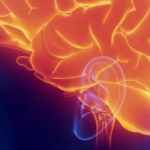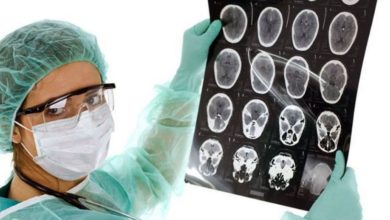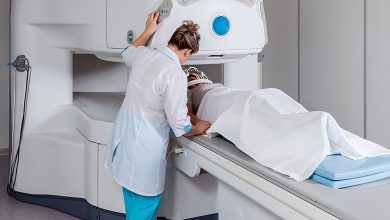Brain stem tumor
The content of the article
Brain stem tumors are neoplasms of the medulla oblongata and midbrain. This condition can present with many symptoms.
The possibility of surgical treatment exists only in 20% of cases with this diagnosis; other patients are prescribed chemotherapy . Tumors can be secondary, that is, those that initially developed in another area and then spread to the trunk. Metastases in this type of cancer are quite rare. The trunk is usually affected from the 4th ventricle and cerebellum. A separate group includes parastem formations. These include tumors that are fused with the trunk, so they lead to its deformation.
It is customary to distinguish three degrees of malignancy:
- Benign.
- Borderline.
- High degree of malignancy.
The first type of formation is characterized by slow growth (it takes about 10 years to grow), malignant ones grow faster - from a couple of months. Benign types are diagnosed in 50% of patients .
Tumor symptoms
General cerebral manifestations include:
- Dizziness and headaches. Pain is the main symptom, and it is associated with the pressure of the formation on the veins, membranes, vessels and nerves of the brain. It can appear all over the head or be localized in the area where the tumor is growing. It appears suddenly and is rarely permanent. Dizziness is also not always observed. The patient may begin to lose balance, noise appears in the ears, and the vision becomes dark.
- Nausea and vomiting. Appears during dizziness and headaches. In addition, a person may begin to feel sick in the morning or on an empty stomach.
- Incorrect position of the head. Reflexively, the head is held in a position in which the cranial and cervical nerves are least irritated.
- Mental disorders. This symptom can be observed with a tumor of any location. The patient may experience a change in consciousness, and irritability may appear. The person talks little, becomes apathetic, and does not respond to calls.
- Epileptic seizures may occur.
- In 70% of patients, vision deterioration and changes in the fundus are observed. This manifests itself in the form of swelling and stagnation of the discs, and their color also changes.
- Bulbar syndrome. The patient's voice becomes quiet, saliva flows from the mouth and he may choke even on liquid food.
Focal symptoms:
- There is a disorder of motor functions, coordination, visual perception, and also a change in gait.
- Hearing and sensitivity decrease.
- Hands begin to shake.
- Facial disorders are observed.
A feature of such tumors is the late manifestation of hydrocephalus and intracranial pressure. Benign tumors may not produce any symptoms for a long time.
Possible reasons
- Genetic predisposition. The presence of genetic diseases such as Gorlin's syndrome, Turco's syndrome, tuberculous sclerosis in 10% of cases is associated with the appearance of AGM.
- Exposure to chemicals.
- Heredity. If a family member has a brain stem tumor, the risk of cancer in the child increases.
Reduced immunity, poor nutrition and environment, bad habits - these factors increase the risk of tumor development. Children under eight years of age and people of retirement age are at risk. The exact causes of the tumor have not yet been established, so experts are unable to prevent this disease.
Stages of the disease
There are four stages of brain cancer:
- First stage. The size of the tumor is no more than 3 cm. It does not spread to organs and other tissues. It can be removed, but at this stage the disease is rarely detected because the symptoms are mild.
- Second stage. Neoplasms larger than 3 cm that do not have distant or regional metastases.
- Third degree: the differences between healthy and cancer cells are significant, the tumor grows and spreads to other brain structures.
- The last one is the most dangerous. Characterized by rapid deterioration of the patient's condition.
Treatment
Brain cancer is more effectively cured by surgery.
- Surgical removal. The doctor is faced with the task of cutting off as much of the tumor as possible, while keeping the loss of healthy tissue to a minimum. To carry out such an intervention, it is necessary to open the skull. In most cases, the operation is prohibited. The decision about whether it is worth it is made based on the size, location and type of tumor. Using a scalpel, it is problematic to cut off the tumor in such a way that all the unaffected tissue around is preserved.
- Radiosurgery – This type of radiation therapy is based on the use of targeted exposure to a high dose of radiation. Such actions should have a devastating effect on cancer cells. This option is used for relapse or metastases. If the formation is benign, the specialist may advise replacing the standard operation with this option.
- HIFU therapy. This is a method of removing a tumor using focused ultrasound. This technique is similar to the previous one, but ultrasound does not have such a detrimental effect on the patient’s health.
- Freezing with nitrogen. This is a fairly gentle, minimally invasive method that allows you to remove cancer without damaging other tissues. Typically, this option is used when the tumor is small in size to remove fragments and metastases that remain after the operation.
Chemotherapy
A few weeks after surgery, additional radiation therapy . Its standard types bring more negativity, so they usually resort to radiotherapy, which minimizes the harmful effects of radiation on tissues that are not damaged by the disease. For this, doctors select the optimal doses. During a course of therapy, the patient undergoes from 10 to 30 procedures, and the total volume of radiation is 70 Gy.
Chemotherapy is most often used in conjunction with radiation. To increase effectiveness, several drugs are prescribed (carmustine, cisplatin and others). Before starting therapy, it is necessary to conduct tests to identify sensitivity to medications.
Prognosis for brain tumor
In general, the prognosis for this condition is poor. Even after complex surgical treatment performed in the early stages, the five-year survival rate ranges from 60 to 80% for various types of tumors. If surgery is not possible or the disease is in an advanced stage, then the probability of surviving 5 years is 30%. People with an aggressive type of cancer have a life expectancy of no more than a year, and sometimes only a few months. It is noteworthy that brain stem tumors in children show higher chances of survival than in adults. This is due to the ability of a growing organism to regenerate.
Please rate the article:





